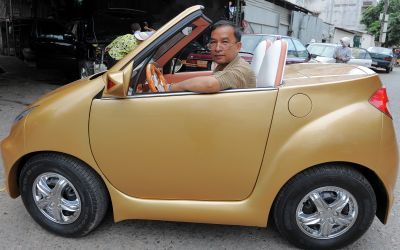'Telepathic' car symbolises Cambodian car industry hopes

The gold-coloured convertible turns heads on impoverished Cambodia's roads -- not least because of creator Nhean Phaloek's outlandish claim that it can be operated telepathically.
The gold-coloured convertible turns heads on impoverished Cambodia's roads - not least because of creator Nhean Phaloek's outlandish claim that it can be operated telepathically.
"I just snap my fingers and the car's door will open. Or I just think of opening the car's door, and the door opens immediately," says the 51-year-old as he proudly shows off the homemade car, named the Angkor 333-2010.
Onlookers gasp as he demonstrates the trick, and with the fibre-glass vehicle having cost him 5,000 dollars and 19 months of labour he is in no mood to reveal the remote control system behind it.
But as with a handful of other Cambodians who make their own curious cars, he dreams the two-seater will help foster an automobile industry in the country, still poor after decades of conflict.
"I am very excited and proud of this car because many people admire me and keep asking me about how I can make it," he says, adding that it reaches speeds of up to 100 kilometres (62 miles) per hour.
Kong Pharith, a 48-year-old former maths and physics teacher who has also produced his own car, says an auto industry is about to blossom in Cambodia.
"Our works will be part of a motivating force for the next generation to access new inventions and show the world that Cambodia has an ability to do what you think we cannot," he says.
The inventor, who first came to national attention in 2005 for building a solar-powered bicycle, thinks he has now hit on a truly unique product with his orange, jeep-like vehicle with solar panels on its roof.
Kong Pharith says it took him four months to design and put the final polish on his "tribrid" car which operates on solar energy, electricity and gasoline, hitting speeds of up to 40 kilometres per hour with its 2,000 watt motor.
"I'm really happy about my achievement but not very satisfied with it yet," he says, adding that Cambodia's lack of modern technology and materials are a minor obstacle to efficient manufacturing.
The dream of building cars in Cambodia may not be far-fetched. Officials have announced plans for South Korean automaker Hyundai to open a plant in southwestern Cambodia, assembling some 3,000 vehicles per year.
Cambodia did actually assemble cars in a factory during the 1960s, before the country was caught in the maelstrom of the Vietnam War.
During the brief manufacturing run, the car known as the "Angkor" was made from imported parts and domestically-made tyres.
Very basic Cambodian-assembled vehicles also still regularly rumble around the countryside, where approximately 80 percent of the country's 14 million people live.
Farmers often depend on "robot cows", large shop-made open-bed trucks with Chinese or Vietnamese engines, which are used to transport people and rice.
The machines, which generally cost a couple of thousand dollars, also serve as generators or water pumps when they are not heaving along pot-holed rural roads.
But in the capital Phnom Penh, elites and the nascent middle class can often be seen driving expensive imports, which are considered a symbol of status and achievement.
"(Cambodians) put more attention into their cars than the clothes they buy," says Jean Boris Roux, who imports Ford vehicles to Cambodia as the country manager for RM Asia.
"I think it's very important for Cambodians to show the success in their professional life through the vehicles they drive," he adds.
Despite the Cambodian love for cars, Roux and several other analysts say its doubtful proper domestic manufacturing will emerge here soon - especially since neighbouring Thailand remains Asia's auto assembly giant.
"It's not just about having four walls (for a factory). You need hundreds of companies supplying seats, steering wheels, hoods... This is not going to happen in Cambodia for a number of years," Roux says.
Until then, Nhean Phaloek says he will keep making cars at home.
The Angkor 333-2010 is the third has built, and his first to talk. When he slams the door a voice out of the dashboard moans: "Why do you close me too strongly?"
"Dozens of local and foreign guests have come and seen my car," Nhean Phaloek says with a smile. "One British man told me that it is the Cambodian James Bond car."
Join our commenting forum
Join thought-provoking conversations, follow other Independent readers and see their replies
Comments